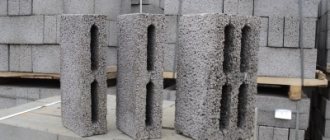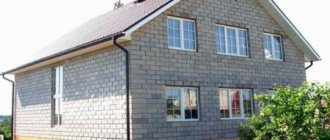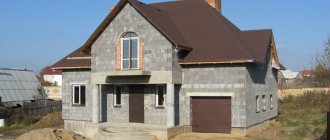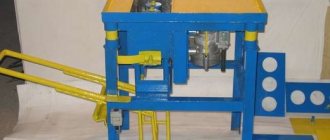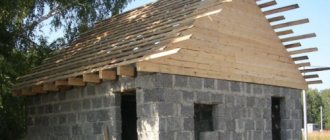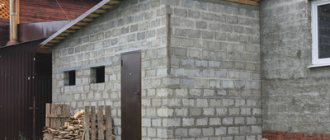- 1 Manufacturing technology
- 2 Preparation of materials and tools
- 3 Preparation of formwork
- 4 Selecting the proportion of expanded clay concrete for mortar
- 5 Molding
- 6 Compact the solution
- 7 Dismantling formwork
- 8 Drying
- 9 Special equipment
Building a house with your own hands is one of the important goals in the life of a real man. If the budget is not limited, you can hire a construction team, and if you want to save money, you will even have to take the production of the material into your own hands. Recently, expanded clay concrete blocks, which have high sound and heat insulation properties and an absolutely environmentally friendly composition, are often used in construction.
Making expanded clay concrete blocks with your own hands is not at all difficult, the main thing is to follow the production technology and buy the required number of components. You will be pleasantly surprised by the results obtained, and will also save your money.
Manufacturing technology
Cement, sand and water are binders, and expanded clay gives the finished material its main qualities. Cement needs grade M400 and higher, sand must be clean and fine. You can add regular washing powder to the composition; it can increase the plastic properties of the mixture. At home, you can also use dishwashing detergent or liquid soap to replace surfactants, which form air pores and increase the frost and moisture resistance of the material. It is better to prepare concrete in a concrete mixer (you can rent one) or manually when a small amount of building material is required. Using a shovel or trowel, carefully add the dry ingredients first, and then add water, stirring.
The expanded clay concrete mixture should stand for some time, then you need to thoroughly mix everything until it becomes a homogeneous mass, reminiscent of plasticine.
Return to contents
Proportions
The technical characteristics of expanded clay blocks are influenced by the proportion of ingredients. In order for the KBB to have high thermal insulation, a large part of expanded clay is used in the solution. Then they cannot be used for main walls. Due to the decrease in strength, they are used for non-load-bearing walls.
Component ratio for CBB:
- 1 part Portland cement M400, M500;
- 6–8 parts of expanded clay or 300–500 kg per 1 m2? mixtures;
- 2 parts sand (fraction 5 mm);
- 1 part water (look at the structure of the solution personally);
- 1 part washing powder or plasticizer.
To prepare 100 kg of solution you need:
- expanded clay? 55 kg;
- sand ? 27 kg;
- cement? 9 kg;
- water? 9 kg.
This is a standard dosage, which is designed for 9–10 KBB with dimensions of 19*19*39 cm.
You can also use a visual table that confirms the percentage of materials in the mixture:
| Cement | Sand | Expanded clay |
| M50? 19% | M50? 46% | M50? 35% |
| M75? 20% | M75? 45% | M75? 35% |
| M100? 23% | M100? 42% | M100? 35% |
| M150? 23% | M150? 49% | M150? 38% |
Preparation of formwork
The interior walls must be lubricated with used motor oil.
To shape the future product, you will need wooden boards at least 2 cm thick, a thin metal sheet, a hacksaw, a tape measure, and a pencil. As for sizes, they usually choose standard ones, for example, brick or cinder block. Having decided on the size, you can start marking, and then use a hacksaw to cut out 3 parts from the boards: a pallet and 2 halves in the form of the letter “L”, then connect everything with metal corners. To make it easier to pull out the blocks, a sheet of metal is nailed to the inside of the boards, and if it is not found, the mold is carefully treated from the inside with machine oil. And so that the shape does not change its size, special closures are made at the ends of the halves.
Return to contents
Methods for producing expanded clay granules
To make expanded clay, one of four methods is used
Dry method
It is used if expanded clay is obtained from dense rocky clayey rocks and shale, a different manufacturing technology is used. The source material is crushed using crushing equipment to obtain grains measuring 1–20 mm. Expanded clay raw materials are fired in a drum kiln, cooled, and distributed into fractions. In this production option, the grain molding step is not provided, and the final product has a cubic angular shape.
Wet method
The clay is placed in large containers called clay mixers. After this, water is poured in to create a slip with a humidity level of up to fifty percent. Pumping units pump it into slurry basins, from where it enters rotary kilns. In the kiln drums, the granules are broken down into individual granules, which are dried by the gases released by the kiln.
The method involves high fuel consumption, since the moisture level of the slip is quite high. But with its help, the raw material is cleared of rocky inclusions, additives are introduced into it to obtain a homogeneous mass. This option is used for raw materials with a high moisture content.
Plastic method
Prepared natural clay, the moisture content of which does not exceed thirty percent, is subjected to two stages of grinding on special gear rollers - coarse and fine. From this process, granules are formed, the diameter of which is 5 - 10 mm, which enter the drying drums. In them, the semi-finished product is dried and subjected to final rolling until it acquires an oval shape. After this, firing begins, for which a temperature regime is created in the furnaces from 800 to 1,350 degrees. The process takes place under constant rotation of the furnace drums. Sintered ceramic granules, which have increased in diameter due to swelling, end up in rotating refrigeration units. After cooling, the final stage begins - the expanded clay is dispersed into fractions.
Powder-plastic method
How is expanded clay produced in this way? The starting material in a dry state is brought to a powdery mass, then water is added to it. As a result, a plastic mass is formed, suitable for the formation of granules. The method is considered quite expensive because the raw materials have to be additionally crushed. The second drawback is that the granules are subject to additional drying.
Since the quality of expanded clay depends on the quality of the raw material, the clay should be well processed and granules of the same size should be formed from it, the parameters of which will increase when expanded.
Molding
The blocks need to be cast in a large room with as level floors as possible. It should not be damp inside, and the recommended air temperature is about 15-18°C. Now you need to place the finished formwork for expanded clay concrete blocks on a flat, hard metal surface and preferably under a canopy, providing protection from direct sunlight and rain.
Before pouring expanded clay concrete, the walls of the mold must be lubricated from the inside with ordinary machine oil, and the base must be lightly sprinkled with sand and only then pour the mixture. To further facilitate the laying of expanded clay blocks, a small amount of expanded clay concrete should be laid. Expanded clay concrete block is usually formed face down and laid out on a pallet.
Return to contents
Compact the solution
Since expanded clay has a large number of air pores, it is lighter than the concrete composition and will float to the surface, making the blocks uneven, therefore, at the very beginning of hardening, expanded clay must be compacted inside the block. According to GOST, expanded clay blocks must first be subjected to vibration pressing using a special machine, and then dried in an oven. At home, the machine can be replaced with similar movements of a shovel, and then tamped with a wooden block until “cement milk” appears on the surface. The top of the block in the mold can be leveled using a trowel.
Return to contents
Advantages and disadvantages
Products with expanded clay filler have a number of advantages compared to other building materials and are characterized by:
- Low weight due to high porosity.
- High soundproofing characteristics.
- Environmental cleanliness associated with the use of natural raw materials.
- Increased thermal insulation, creating a comfortable microclimate in the room.
- Increased strength to withstand significant loads.
- Low coefficient of expansion, preventing cracking;
- Frost resistance, allowing you to safely tolerate deep freezing.
Having many advantages, composites have minor disadvantages:
- the problematic use in the construction of multi-storey structures associated with the structural features;
- narrow scope of use of products with cavities caused by design features.
Special equipment
If you don’t mind your money, buying special equipment for high-quality material will not be superfluous. It will make it easier to make expanded clay blocks with your own hands, improve their quality, and reduce drying time. First of all, you need to choose a level, preferably concrete, base that will reduce vibration that can destroy the finished blocks. The special platform can be replaced with pallets.
A concrete mixer is an indispensable thing when mixing concrete mortar; it will make it perfectly homogeneous. It is better to buy a mechanism with a volume of at least 130 liters. Vibropressing machine. It consists of a housing, which already contains containers with voids, and a vibrator. The production process of one block takes no more than 3 minutes. Using such a machine, it is possible to produce paving slabs, curbs, and wall blocks at minimal cost
Having at least this list of equipment, in one day you can really get your head around and prepare about 150 expanded clay blocks with your own labor. If you invite a team, the productivity will double, or even triple.
What is needed for home production of expanded clay concrete blocks
In addition to, of course, materials, you need a minimum set of equipment.
Let's consider two options:
- you are going to make a one-time small number of blocks for a small building;
- You need to put the production of expanded clay concrete blocks on stream with your own hands due to the large volume of construction, or the plans include the sale of blocks.
For small production volume
Manual filling of the mold with solution
For a small production volume, the gravity concrete mixer available to almost every owner is quite sufficient.
If you need to make several hundred pieces of expanded clay concrete blocks, for example, to build a garage, then you can get by with a minimum amount of equipment.
It could just be:
- You have a gravity concrete mixer. For high-quality mixing, the operation should be carried out not two to three minutes, as for heavy concrete, but one and a half to two times longer.
- Molds or a machine for the production of expanded clay concrete blocks with your own hands.
- Vibrating table - as a last resort, you can compact the mixture with a tamper, but this will make the process longer and more labor-intensive. In addition, when working with expanded clay concrete with a tamper, you need to accurately calculate the force so as not to crush the granules.
- Tool for loading and dispensing components - carts, buckets, shovels, etc.
If you are going to put production on stream
An example of production designed for a decent volume - there is even an electric hoist for moving materials and blocks
- In this case, it is advisable to use a forced-action concrete mixer. It is desirable to mechanize the process of transporting components, mixtures and finished products.
- The easiest way to do this is to mount a beam crane on the site, or purchase an electric car with a front lift.
- Also, to speed up the process, and in order not to occupy a large area for the landfill on which the manufactured blocks will harden, you can mount a steaming device (more on this below).
Let's take a closer look at each piece of equipment.
Concrete mixer
For expanded clay concrete it is better to use a forced concrete mixer
Its design is standard. As mentioned above, a forced mixing apparatus is better for expanded clay concrete. We select the volume of the mixer so that we can mold the prepared portion of the mixture in one to two hours, until hardening begins.
Vibrating table
Homemade vibration table
Not counting the mixer, this is the most expensive unit required for the production of blocks. But you can’t do without it, unless you use a submersible vibrator, which is a little cheaper, when making solid products. But this approach is impractical, as it will delay the manufacturing process.
It is difficult to purchase a vibrating table in a construction tool store. But it can be easily ordered. The price for this device starts from 10 thousand rubles. You can also make it yourself.
The design is simple and consists of only a few components:
- base (frame);
- the area on which compaction occurs (the table itself);
- shock absorbers on which the table is mounted, you can use springs from a car suspension, suitable rubber cushions;
- vibrator, instead of an industrial device, you can install a motor with an eccentric on the shaft. Or even better - a separate eccentric connected to the motor via a belt drive.
For better quality work, it is advisable to have two or more vibrators. We choose the area of the table such that it can accommodate a machine for making blocks, or the maximum number of molds.
Attention. When designing and assembling a vibrating table yourself, especially with one vibrator, the problem of structural resonance may arise. It is expressed in the fact that the table sharply increases the amplitude of its vibrations, dragging the base with it and even displacing the entire unit from its place. You can get rid of this phenomenon by changing the mass of the load on the eccentric or the gear ratio or engine rotation speed.
Forms
One of the options for a homemade form
The simplest forms are easy to make with a minimum of tools. You can choose several options for your production.
- Made from wood or a combination of it with other sheet materials, for example: a wooden frame, and tin or textolite walls. The tree will not last long, but for a small series it is a completely acceptable option.
- Make it from metal if you have a welding machine and skills. With proper care, metal molds can last for several years and are easy to lubricate and clean.
Advice. Do not make molds with removable sides, they are less reliable. With the correct selection of the mixture composition, the workpiece can be easily removed from the mold.
- Buy ready-made metal or polymer molds.
There is another way to make molds - make them from fiberglass. But it's too labor intensive. To create a mold, you need to make a model of our block, then cover it with several layers of fiberglass on epoxy resin.
Block making machine
Homemade machine for expanded clay concrete blocks
Designed for simultaneous production of blanks of several blocks. It either performs only preliminary forming, or the mixture is immediately compacted (if vibrators are built into the machine).
You can purchase a ready-made machine, or try to make it yourself, as in the video in this article. Its design can be very diverse.
The simplest and most common of the following nodes:
- Shape block - combinations of several shapes.
- A device for loading concrete mixture - trays or conveyors for supplying concrete to all forms at once.
- Devices (most often manually driven) - for pre-compaction by pressing the mixture, and removing the workpiece from the mold.
